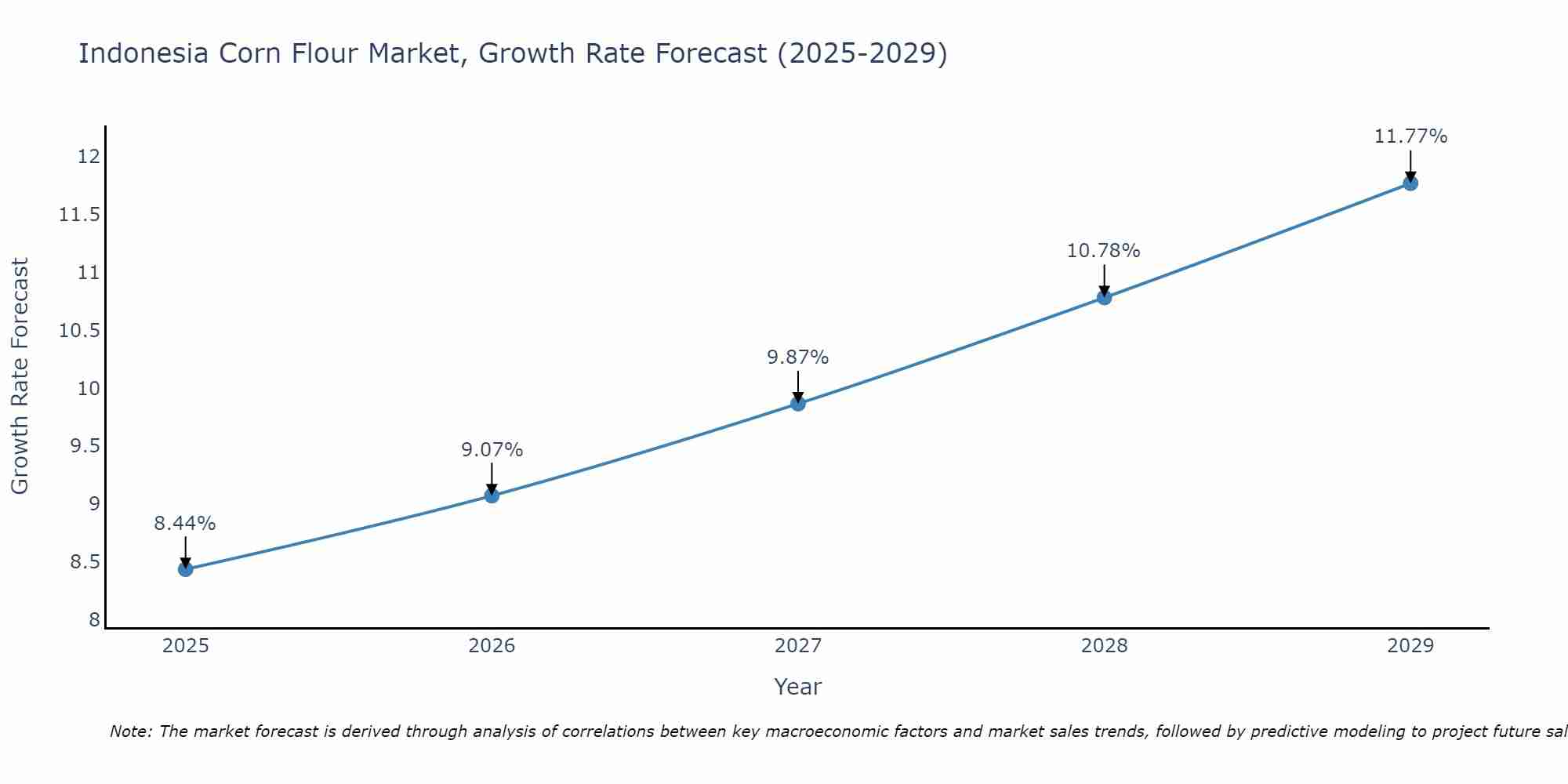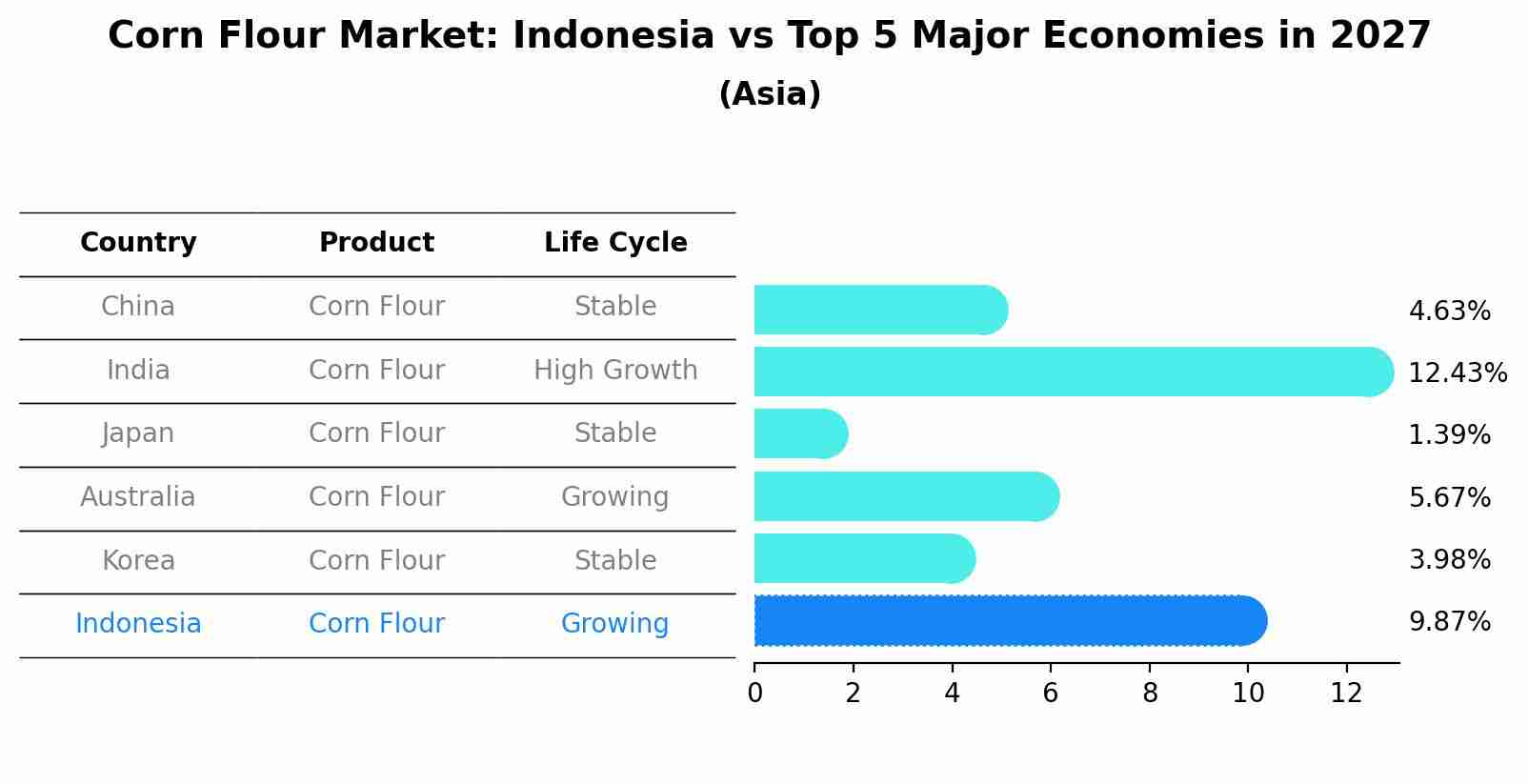Indonesia Corn Flour Market | Share, Growth, Value, Size, Industry, Analysis, Revenue, COVID-19 IMPACT, Companies, Forecast & Trends
| Product Code: ETC178967 | Publication Date: Jul 2023 | Updated Date: Aug 2025 | Product Type: Market Research Report | |
| Publisher: 6Wresearch | No. of Pages: 70 | No. of Figures: 35 | No. of Tables: 5 | |
Indonesia Corn Flour Market Size Growth Rate
The Indonesia Corn Flour Market is likely to experience consistent growth rate gains over the period 2025 to 2029. The growth rate starts at 8.44% in 2025 and reaches 11.77% by 2029.

Corn Flour Market: Indonesia vs Top 5 Major Economies in 2027 (Asia)
In the Asia region, the Corn Flour market in Indonesia is projected to expand at a growing growth rate of 9.87% by 2027. The largest economy is China, followed by India, Japan, Australia and South Korea.

Indonesia Corn Flour Market Synopsis
Corn flour, also known as maize flour, is a popular grain-based product derived from the dried kernels of corn. The production and consumption of corn flour have been steadily increasing in Indonesia over the past few years due to its many health benefits such as being low in fat and high in fiber. Corn flour is widely used for preparing traditional Indonesia foods like cakes, cookies, pancakes, porridge etc., making it an important ingredient in the local food industry.
Market Trends
The demand for corn flour has grown rapidly over the last few years mainly due to rising awareness among consumers about its nutritional benefits. As more people become health conscious and look for healthier alternatives to their staple diets, they are increasingly opting for products made with whole grain ingredients like cornflour. This trend will continue to drive growth in the market going forward. In addition to this, advancements in milling technology have enabled manufacturers to produce higher quality products at lower costs which has further helped boost demand for cornflour across Indonesia.
Market Drivers
The key factors driving growth of the Indonesia cornflour market include changing consumer preferences towards healthier food options; growing awareness among consumers about nutrition and diet; technological advances that allow manufacturing processes at lower cost; availability of raw materials used for producing maize flour such as process engineering equipment and improved storage systems; government initiatives promoting agricultural exports; increasing disposable incomes leading households to spend on premium food items including those made using maize or other grains based flours etc. All these factors are expected to fuel further growth prospects of this market over next 5-7 years time frame.
COVID-19 Impact on the Market
The outbreak of the coronavirus has had a significant impact on Indonesia corn flour market. The disruption in international trade due to restrictions imposed by countries across the globe, has resulted in reduced availability of raw materials for millers and manufacturers. This has caused an increase in production costs, leading to increased prices for consumers. Additionally, with consumers? incomes being impacted by the pandemic, demand for corn flour products have also declined significantly.
Challenges of the Market
One of the major challenges facing Indonesia corn flour industry is supply chain disruption caused by COVID-19 related travel restrictions and other preventative measures implemented by governments around the world. This has led to reduced access to imported commodities such as wheat, maize and barley which are key ingredients used in producing corn flours. Furthermore, with increased production costs due to shortages or limited supplies of raw materials, manufacturers have had difficulty controlling product prices within acceptable levels set out by government regulations aimed at protecting low income households from rising food prices during this difficult period.
Industry Key Players
The major players operating within Indonesia Corn Flour Market include Sinar Mas Agro Resources & Technology Tbk (SMART), PT Indofood Sukses Makmur (Indofood), BOGASARI FLOUR MILLS , PT PANGESTU STARMAS LEBAKINDO , Multi Bintang Indonesia Tbk., Nihon Shokken Group Co Ltd., Dufil Prima Foods Plc., British American Tobacco Company Ltd (BAT) amongst many others.
Key Highlights of the Report:
- Indonesia Corn Flour Market Outlook
- Market Size of Indonesia Corn Flour Market, 2023
- Forecast of Indonesia Corn Flour Market, 2030
- Historical Data and Forecast of Indonesia Corn Flour Revenues & Volume for the Period 2020-2030
- Indonesia Corn Flour Market Trend Evolution
- Indonesia Corn Flour Market Drivers and Challenges
- Indonesia Corn Flour Price Trends
- Indonesia Corn Flour Porter's Five Forces
- Indonesia Corn Flour Industry Life Cycle
- Historical Data and Forecast of Indonesia Corn Flour Market Revenues & Volume By Application for the Period 2020-2030
- Historical Data and Forecast of Indonesia Corn Flour Market Revenues & Volume By Bakery And Confectionary for the Period 2020-2030
- Historical Data and Forecast of Indonesia Corn Flour Market Revenues & Volume By Snack Food for the Period 2020-2030
- Historical Data and Forecast of Indonesia Corn Flour Market Revenues & Volume By Others for the Period 2020-2030
- Historical Data and Forecast of Indonesia Corn Flour Market Revenues & Volume By Distribution Channel for the Period 2020-2030
- Historical Data and Forecast of Indonesia Corn Flour Market Revenues & Volume By Online Retail for the Period 2020-2030
- Historical Data and Forecast of Indonesia Corn Flour Market Revenues & Volume By Supermarkets/Hypermarkets for the Period 2020-2030
- Historical Data and Forecast of Indonesia Corn Flour Market Revenues & Volume By Convenience Stores for the Period 2020-2030
- Historical Data and Forecast of Indonesia Corn Flour Market Revenues & Volume By Others for the Period 2020-2030
- Indonesia Corn Flour Import Export Trade Statistics
- Market Opportunity Assessment By Application
- Market Opportunity Assessment By Distribution Channel
- Indonesia Corn Flour Top Companies Market Share
- Indonesia Corn Flour Competitive Benchmarking By Technical and Operational Parameters
- Indonesia Corn Flour Company Profiles
- Indonesia Corn Flour Key Strategic Recommendations
Frequently Asked Questions About the Market Study (FAQs):
1 Executive Summary |
2 Introduction |
2.1 Key Highlights of the Report |
2.2 Report Description |
2.3 Market Scope & Segmentation |
2.4 Research Methodology |
2.5 Assumptions |
3 Indonesia Corn Flour Market Overview |
3.1 Indonesia Country Macro Economic Indicators |
3.2 Indonesia Corn Flour Market Revenues & Volume, 2020 & 2030F |
3.3 Indonesia Corn Flour Market - Industry Life Cycle |
3.4 Indonesia Corn Flour Market - Porter's Five Forces |
3.5 Indonesia Corn Flour Market Revenues & Volume Share, By Application, 2020 & 2030F |
3.6 Indonesia Corn Flour Market Revenues & Volume Share, By Distribution Channel, 2020 & 2030F |
4 Indonesia Corn Flour Market Dynamics |
4.1 Impact Analysis |
4.2 Market Drivers |
4.2.1 Increasing demand for gluten-free products |
4.2.2 Growing awareness about the health benefits of corn flour |
4.2.3 Rise in disposable income leading to higher purchasing power |
4.3 Market Restraints |
4.3.1 Fluctuations in raw material prices |
4.3.2 Competition from other alternative flours in the market |
5 Indonesia Corn Flour Market Trends |
6 Indonesia Corn Flour Market, By Types |
6.1 Indonesia Corn Flour Market, By Application |
6.1.1 Overview and Analysis |
6.1.2 Indonesia Corn Flour Market Revenues & Volume, By Application, 2020-2030F |
6.1.3 Indonesia Corn Flour Market Revenues & Volume, By Bakery And Confectionary, 2020-2030F |
6.1.4 Indonesia Corn Flour Market Revenues & Volume, By Snack Food, 2020-2030F |
6.1.5 Indonesia Corn Flour Market Revenues & Volume, By Others, 2020-2030F |
6.2 Indonesia Corn Flour Market, By Distribution Channel |
6.2.1 Overview and Analysis |
6.2.2 Indonesia Corn Flour Market Revenues & Volume, By Online Retail, 2020-2030F |
6.2.3 Indonesia Corn Flour Market Revenues & Volume, By Supermarkets/Hypermarkets, 2020-2030F |
6.2.4 Indonesia Corn Flour Market Revenues & Volume, By Convenience Stores, 2020-2030F |
6.2.5 Indonesia Corn Flour Market Revenues & Volume, By Others, 2020-2030F |
7 Indonesia Corn Flour Market Import-Export Trade Statistics |
7.1 Indonesia Corn Flour Market Export to Major Countries |
7.2 Indonesia Corn Flour Market Imports from Major Countries |
8 Indonesia Corn Flour Market Key Performance Indicators |
8.1 Average selling price of corn flour |
8.2 Number of new product launches in the corn flour segment |
8.3 Consumer satisfaction and repeat purchase rate |
9 Indonesia Corn Flour Market - Opportunity Assessment |
9.1 Indonesia Corn Flour Market Opportunity Assessment, By Application, 2020 & 2030F |
9.2 Indonesia Corn Flour Market Opportunity Assessment, By Distribution Channel, 2020 & 2030F |
10 Indonesia Corn Flour Market - Competitive Landscape |
10.1 Indonesia Corn Flour Market Revenue Share, By Companies, 2023 |
10.2 Indonesia Corn Flour Market Competitive Benchmarking, By Operating and Technical Parameters |
11 Company Profiles |
12 Recommendations |
13 Disclaimer |
- Single User License$ 1,995
- Department License$ 2,400
- Site License$ 3,120
- Global License$ 3,795
Search
Related Reports
- UAE Building Thermal Insulation Market Outlook (2025-2031) | Revenue, Companies, Share, Trends, Growth, Size, Forecast, Industry, Analysis & Value
- Portugal Electronic Document Management Market (2025-2031) | Strategy, Consumer Insights, Analysis, Investment Trends, Opportunities, Growth, Size, Share, Industry, Revenue, Segments, Value, Segmentation, Supply, Forecast, Restraints, Outlook, Competition, Drivers, Trends, Demand, Pricing Analysis, Competitive, Strategic Insights, Companies, Challenges
- France Electronic Document Management Market (2025-2031) | Strategy, Consumer Insights, Analysis, Investment Trends, Opportunities, Growth, Size, Share, Industry, Revenue, Segments, Value, Segmentation, Supply, Forecast, Restraints, Outlook, Competition, Drivers, Trends, Demand, Pricing Analysis, Competitive, Strategic Insights, Companies, Challenges
- Portugal Occupational Health & Safety Services Market (2025-2031) | Strategy, Consumer Insights, Analysis, Investment Trends, Opportunities, Growth, Size, Share, Industry, Revenue, Segments, Value, Segmentation, Supply, Forecast, Restraints, Outlook, Competition, Drivers, Trends, Demand, Pricing Analysis, Competitive, Strategic Insights, Companies, Challenges
- Netherlands Occupational Health and Safety Services Market (2025-2031) | Strategy, Consumer Insights, Analysis, Investment Trends, Opportunities, Growth, Size, Share, Industry, Revenue, Segments, Value, Segmentation, Supply, Forecast, Restraints, Outlook, Competition, Drivers, Trends, Demand, Pricing Analysis, Competitive, Strategic Insights, Companies, Challenges
- Belgium and Luxembourg Facility Management Market (2025-2031) | Strategy, Consumer Insights, Analysis, Investment Trends, Opportunities, Growth, Size, Share, Industry, Revenue, Segments, Value, Segmentation, Supply, Forecast, Restraints, Outlook, Competition, Drivers, Trends, Demand, Pricing Analysis, Competitive, Strategic Insights, Companies, Challenges
- Russia Women Intimate Apparel Market (2025-2031) | Strategy, Consumer Insights, Analysis, Investment Trends, Opportunities, Growth, Size, Share, Industry, Revenue, Segments, Value, Segmentation, Supply, Forecast, Restraints, Outlook, Competition, Drivers, Trends, Demand, Pricing Analysis, Competitive, Strategic Insights, Companies, Challenges
- Africa Chocolate Market (2025-2031) | Size, Share, Trends, Growth, Revenue, Analysis, Forecast, industry & Outlook
- Global Hydroxychloroquine And Chloroquine Market (2025-2031) | Industry, Trends, Size, Outlook, Growth, Value, Companies, Revenue, Analysis, Share, Forecast
- Saudi Arabia Plant Maintenance Market (2025-2031) | Industry, Size, Growth, Revenue, Value, Companies, Forecast, Analysis, Share & Trends
Industry Events and Analyst Meet
Our Clients
Whitepaper
- Middle East & Africa Commercial Security Market Click here to view more.
- Middle East & Africa Fire Safety Systems & Equipment Market Click here to view more.
- GCC Drone Market Click here to view more.
- Middle East Lighting Fixture Market Click here to view more.
- GCC Physical & Perimeter Security Market Click here to view more.
6WResearch In News
- Doha a strategic location for EV manufacturing hub: IPA Qatar
- Demand for luxury TVs surging in the GCC, says Samsung
- Empowering Growth: The Thriving Journey of Bangladesh’s Cable Industry
- Demand for luxury TVs surging in the GCC, says Samsung
- Video call with a traditional healer? Once unthinkable, it’s now common in South Africa
- Intelligent Buildings To Smooth GCC’s Path To Net Zero













